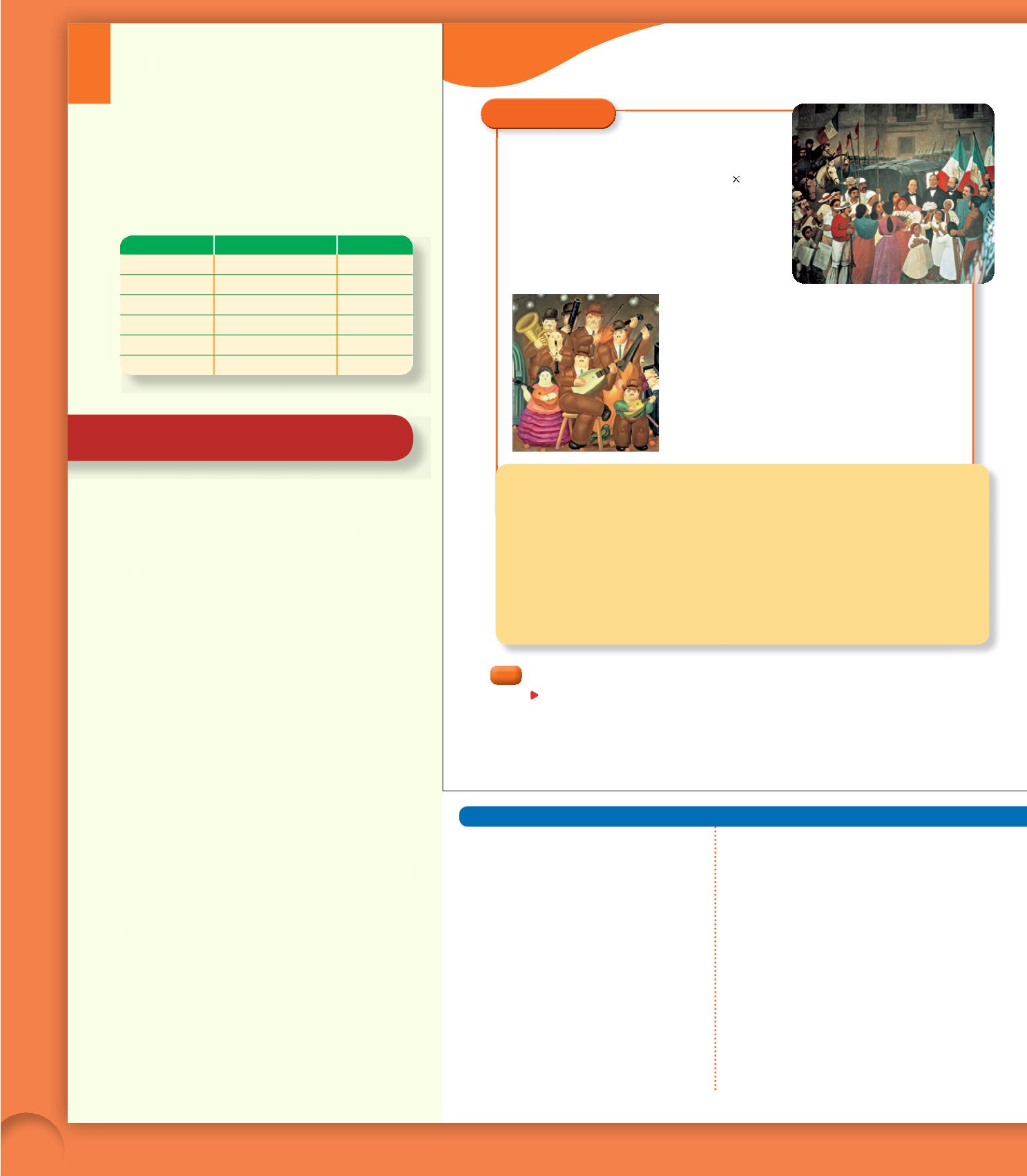

Book 4 Unit 6
74
Vocabulario
DESAFÍO 1
1
1
El intruso
Busca
el intruso en cada serie y justifica tu respuesta.
1.
volumen-perspectiva-proporción-lienzo
2.
retrato-pincel-mural-paisaje
3.
vivo-oscuro-apagado-preciso
Arte y pintura
El pintor mexicano José Clemente Orozco realizó este
mural
en 1967. Es una obra de gran
tamaño
; mide 5,90
3
4,50
metros. La escena muestra la alegría del pueblo ante la
llegada del presidente Juárez, a quien vemos en el centro.
Frente a él, en
primer plano
, un grupo de niñas le ofrecen
flores. Al
fondo
vemos a las tropas de Porfirio Díaz.
El estilo de Orozco se caracteriza por el uso de líneas
simples y
pinceladas precisas
, pero sobre todo
destaca
el contraste de
colores vivos
y
apagados
.
Los muralistas Diego Rivera y Orozco
influyeron
en gran medida
en Fernando Botero, que también trata temas sociales
y políticos en sus obras.
Botero se caracteriza por un
innovador
tratamiento de la figura
humana, que presenta un
volumen exagerado
. En este cuadro
juega con la
proporción
y con la
perspectiva
. Sus pinceladas
muestran muchos detalles en las
formas
.
Fernando Botero.
Los músicos
(1980).
Óleo
sobre
lienzo
.
José Clemente Orozco.
Entrada triunfal
de Benito Juárez al Palacio Nacional
acompañado de su gabinete
(1967).
Más vocabulario
Pintura
la acuarela: pintura sobre papel o cartón
con colores diluidos en agua.
el boceto: dibujo que se realiza antes
de la obra.
el paisaje: pintura que representa el terreno.
el pincel: instrumento alargado con pelos
en uno de sus extremos que se usa
para pintar.
el retrato: pintura de una persona.
Estilos artísticos
arte figurativo: estilo artístico que representa
la realidad de forma concreta y reconocible,
al contrario que el arte abstracto.
cubismo: estilo artístico basado en el uso
de formas geométricas.
surrealismo: estilo artístico que representa
lo imaginario y lo irracional.
¡Atención!
darse cuenta
to realize
realizar
to achieve
Presentation
.
In this section, students will learn vocabulary
used to talk about paintings and artistic styles.
Activities
Standards
Resources
Vocabulario 1.2, 2.1, 2.2, 3.1
11.
1.2
12.
1.1, 1.3, 3.1
13.
1.2, 1.3, 2.2, 3.1 Audio
14.
1.1, 3.1
15. Cultura 1.2, 2.2, 3.1, 5.2
Teaching Suggestions
Warm-Up/ Independent Starter
.
Ask students to create a two-column chart and
label the columns with these headings:
Colores
vivos, Colores apagados
. Have students list colors
they associate with each category.
Preparation
.
Go over the vocabulary presentation with
students. Ask them to identify the colors they
observe in the two paintings and state which
colors are
vivos
and which are
apagados
. Have
students refer back to their lists from the
Independent Starter. As a class, discuss how the
color affects the message of the painting.
.
Have students work with a partner to prepare
comprehension questions using the text. Then
have them quiz another student pair.
Activities
11.
To extend this activity, have students write their
own lists of four words to share with the class,
and call on volunteers to identify the word that
does not belong.
12.
As an alternative to this activity, ask students to
write definitions for six vocabulary words that
appear in the text or in the
Más vocabulario
feature, and then have their partner identify the
correct word. Or, if you have access to small
whiteboards, say a definition to students and
have them write the correct word on their
boards. You may wish to turn this into
a competition.
Vocabulario – Arte y pintura
DESAFÍO 1
Unit
6
DEVELOPING LEARNERS
r
Ask students to match the words.
1.
influir
(g)
a.
proyecto
2.
exagerado
(j)
b.
exacto
3.
fondo
(f)
c.
tipo de pintura
4.
boceto
(a)
d.
resaltar
5.
óleo
(c)
e.
comprender
6.
paisaje
(h)
f.
zona alejada
7.
destacar
(d)
g.
ejercer un efecto
8.
darse cuenta
(e)
h.
representación del
terreno
9.
preciso
(b)
i.
brillante
10.
vivo
(i)
j.
excesivo
EXPANDING LEARNERS
r
Ask students to indicate which word does
not belong and explain why.
1.
óleo
pincel
acuarela (pincel)
2.
vivo
preciso apagado (preciso)
3.
figuras formas escenas (escenas)
4.
retrato boceto paisaje (boceto)
5.
mural
tamaño volumen (mural)
6.
figura fondo
primer plano (figura)
7.
paisaje proporción perspectiva (paisaje)
8.
lienzo escena cartón (escena)
9.
realizar destacar conseguir (destacar)
10.
realista abstracto figurativo (abstracto)
Differentiated Instruction
306


















